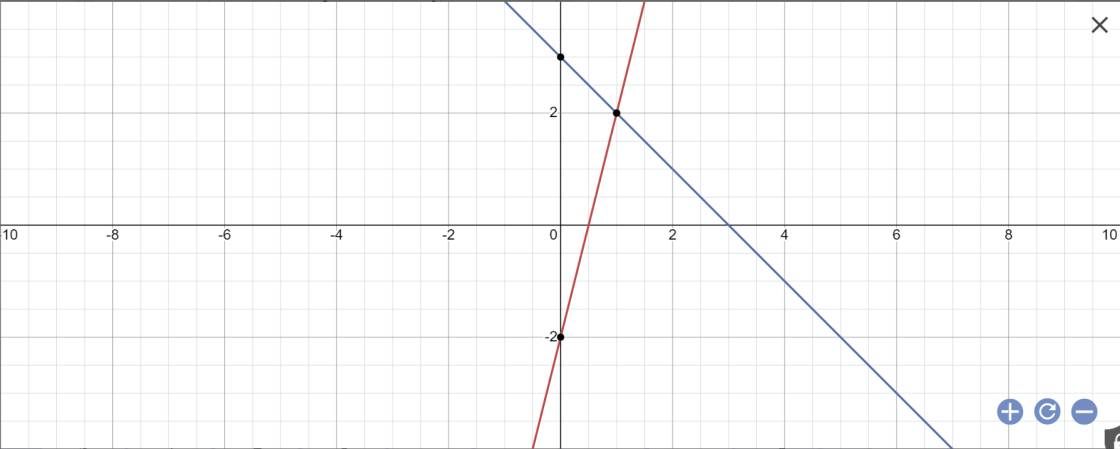a. Vẽ trên cùng mặt phẳng toạ đồ Oxy đồ thị của các hàm số sau:
b. Tìm toạ độ giao điểm M của hai đường thẳng (d1) và (d2).
c. Tính góc a tạo bởi đường thẳng (d2) và trục hoành Ox
Hãy nhập câu hỏi của bạn vào đây, nếu là tài khoản VIP, bạn sẽ được ưu tiên trả lời.

b:
Goi a1,a2 lần lượt là số đo góc tạo bởi (d1), (d2) với trục Ox
tan a1=1
=>a1=45 độ
tan a2=-1
=>a2=135 độ
c: Tọa độ C là:
x+1=-x+3 và y=x+1
=>x=1 và y=2
d: Thay x=1 và y=2 vào y=mx+m-1, ta được:
m+m-1=2
=>2m-1=2
=>2m=3
=>m=3/2

a: 
b: Phương trình hoành độ giao điểm là:
4x-2=-x+3
=>4x+x=3+2
=>5x=5
=>x=1
Thay x=1 vào y=-x+3, ta được:
\(y=-1+3=2\)
Vậy: M(1;2)
c: Gọi \(\alpha;\beta\) lần lượt là góc tạo bởi (d1),(d2) với trục Ox
(d1): y=4x-2
=>\(tan\alpha=4\)
=>\(\alpha=76^0\)
(d2): y=-x+3
=>\(tan\beta=-1\)
=>\(\beta=135^0\)
d: Thay y=6 vào (d1), ta được:
4x-2=6
=>4x=8
=>x=2
=>A(2;6)
Thay x=6/2=3 vào (d2), ta được:
\(y=-3+3=0\)
vậy: B(3;0)
Vì (d):y=ax+b đi qua A(2;6) và B(3;0) nên ta có hệ phương trình:
\(\left\{{}\begin{matrix}2a+b=6\\3a+b=0\end{matrix}\right.\)
=>\(\left\{{}\begin{matrix}2a+b-3a-b=6-0\\3a+b=0\end{matrix}\right.\Leftrightarrow\left\{{}\begin{matrix}-a=6\\b=-3a\end{matrix}\right.\)
=>\(\left\{{}\begin{matrix}a=-6\\b=-3\cdot\left(-6\right)=18\end{matrix}\right.\)
Vậy: (d): y=-6x+18
e: A(2;6); B(3;0); M(1;2)
\(AM=\sqrt{\left(1-2\right)^2+\left(2-6\right)^2}=\sqrt{17}\)
\(BM=\sqrt{\left(1-3\right)^2+\left(2-0\right)^2}=2\sqrt{2}\)
\(AB=\sqrt{\left(3-2\right)^2+\left(0-6\right)^2}=\sqrt{37}\)
Chu vi tam giác AMB là:
\(C_{AMB}=\sqrt{17}+2\sqrt{2}+\sqrt{37}\)
Xét ΔAMB có
\(cosAMB=\dfrac{MA^2+MB^2-AB^2}{2\cdot MA\cdot MB}=\dfrac{17+8-37}{2\cdot2\sqrt{2}\cdot\sqrt{17}}=\dfrac{-3}{\sqrt{34}}\)
=>\(\widehat{AMB}\simeq121^0\) và \(sinAMB=\sqrt{1-\left(-\dfrac{3}{\sqrt{34}}\right)^2}=\dfrac{5}{\sqrt{34}}\)
Xét ΔAMB có
\(\dfrac{AB}{sinAMB}=\dfrac{AM}{sinABM}=\dfrac{BM}{sinBAM}\)
=>\(\dfrac{\sqrt{17}}{sinABM}=\dfrac{2\sqrt{2}}{sinBAM}=\sqrt{37}:\dfrac{5}{\sqrt{34}}\)
=>\(sinABM\simeq0,58;\widehat{BAM}\simeq0,4\)
=>\(\widehat{ABM}\simeq35^0;\widehat{BAM}\simeq24^0\)

b: Tọa độ giao điểm là:
\(\left\{{}\begin{matrix}4-2x=3x+1\\y=3x+1\end{matrix}\right.\Leftrightarrow\left\{{}\begin{matrix}x=\dfrac{3}{5}\\y=\dfrac{9}{5}+1=\dfrac{14}{5}\end{matrix}\right.\)

a/ bạn tự làm
b/ \(\Rightarrow y=0\Rightarrow\dfrac{1}{2}x+2=0\) giải PT tìm hoành độ x
c/ \(\Rightarrow x=0\Rightarrow y=0+2=2\)
d/ \(\Rightarrow\dfrac{1}{2}x+2=-x+2\) Giải PT tìm hoành độ x của C rồi thay vào d1 hoặc d2 để tìm tung độ y của C

\(b,\text{PT giao Ox của }\left(d_2\right):y=0\Leftrightarrow-x+3=0\Leftrightarrow x=3\Leftrightarrow B\left(3;0\right)\Leftrightarrow OB=3\\ \text{PTHĐGĐ }\left(d_1\right)\text{ và }\left(d_2\right):2x=-x+3\Leftrightarrow x=1\Leftrightarrow y=2\Leftrightarrow A\left(1;2\right)\\ \text{Gọi }H\text{ là đường cao từ }A\text{ của }\Delta OAB\\ \Rightarrow AH=\left|y_A\right|=2\\ \Rightarrow S_{OAB}=\dfrac{1}{2}AH\cdot OB=\dfrac{1}{2}\cdot2\cdot3=3\left(đvdt\right)\)

\(b,\) PT hoành độ giao điểm: \(-2x+5=x+2\Leftrightarrow x=1\Leftrightarrow y=3\Leftrightarrow M\left(1;3\right)\)